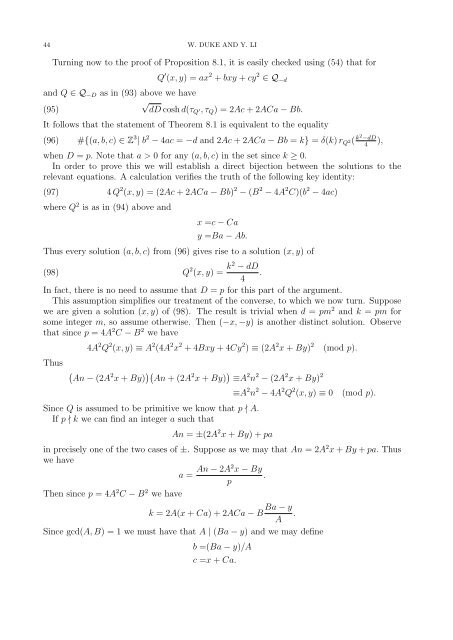Mock-modular forms of weight one - UCLA Department of Mathematics
Mock-modular forms of weight one - UCLA Department of Mathematics
Mock-modular forms of weight one - UCLA Department of Mathematics
Create successful ePaper yourself
Turn your PDF publications into a flip-book with our unique Google optimized e-Paper software.
Thus<br />
(An<br />
− (2A 2 x + By) )( An + (2A 2 x + By) ) ≡A 2 n 2 − (2A 2 x + By) 2<br />
44 W. DUKE AND Y. LI<br />
Turning now to the pro<strong>of</strong> <strong>of</strong> Proposition 8.1, it is easily checked using (54) that for<br />
Q ′ (x, y) = ax 2 + bxy + cy 2 ∈ Q −d<br />
and Q ∈ Q −D as in (93) above we have<br />
√<br />
(95)<br />
dD cosh d(τQ ′, τ Q ) = 2Ac + 2ACa − Bb.<br />
It follows that the statement <strong>of</strong> Theorem 8.1 is equivalent to the equality<br />
(96) #{(a, b, c) ∈ Z 3 | b 2 − 4ac = −d and 2Ac + 2ACa − Bb = k} = δ(k) r Q 2( k2 −dD<br />
4<br />
),<br />
when D = p. Note that a > 0 for any (a, b, c) in the set since k ≥ 0.<br />
In order to prove this we will establish a direct bijection between the solutions to the<br />
relevant equations. A calculation verifies the truth <strong>of</strong> the following key identity:<br />
(97) 4 Q 2 (x, y) = (2Ac + 2ACa − Bb) 2 − (B 2 − 4A 2 C)(b 2 − 4ac)<br />
where Q 2 is as in (94) above and<br />
x =c − Ca<br />
y =Ba − Ab.<br />
Thus every solution (a, b, c) from (96) gives rise to a solution (x, y) <strong>of</strong><br />
(98) Q 2 (x, y) = k2 − dD<br />
.<br />
4<br />
In fact, there is no need to assume that D = p for this part <strong>of</strong> the argument.<br />
This assumption simplifies our treatment <strong>of</strong> the converse, to which we now turn. Suppose<br />
we are given a solution (x, y) <strong>of</strong> (98). The result is trivial when d = pm 2 and k = pm for<br />
some integer m, so assume otherwise. Then (−x, −y) is another distinct solution. Observe<br />
that since p = 4A 2 C − B 2 we have<br />
4A 2 Q 2 (x, y) ≡ A 2 (4A 2 x 2 + 4Bxy + 4Cy 2 ) ≡ (2A 2 x + By) 2<br />
(mod p).<br />
Since Q is assumed to be primitive we know that p ∤ A.<br />
If p ∤ k we can find an integer a such that<br />
An = ±(2A 2 x + By) + pa<br />
≡A 2 n 2 − 4A 2 Q 2 (x, y) ≡ 0<br />
(mod p).<br />
in precisely <strong>one</strong> <strong>of</strong> the two cases <strong>of</strong> ±. Suppose as we may that An = 2A 2 x + By + pa. Thus<br />
we have<br />
a = An − 2A2 x − By<br />
.<br />
p<br />
Then since p = 4A 2 C − B 2 we have<br />
k = 2A(x + Ca) + 2ACa − B Ba − y<br />
A .<br />
Since gcd(A, B) = 1 we must have that A | (Ba − y) and we may define<br />
b =(Ba − y)/A<br />
c =x + Ca.
















